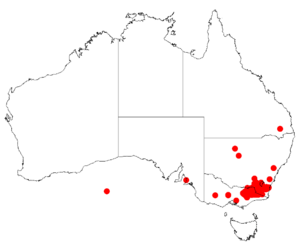Buffalo wattle facts for kids
Quick facts for kids Buffalo wattle |
|
|---|---|
| Scientific classification | |
| Genus: |
Acacia
|
| Species: |
kettlewelliae
|
 |
|
| Occurrence data from AVH | |
Acacia kettlewelliae, also known as buffalo wattle, is a type of tree or shrub. It belongs to the Acacia family, which is a large group of plants. This plant is special because it only grows naturally in certain parts of southeastern Australia.
Contents
About the Buffalo Wattle Plant
This tree or shrub usually grows to be about 2 to 10 metres (7 to 33 ft) tall. It often has a bushy shape. Its small branches are smooth and have angles at their ends.
Like most Acacia plants, the buffalo wattle does not have true leaves. Instead, it has special flattened stems called phyllodes. These phyllodes look and act like leaves. They are thin and stay green all year round.
The phyllodes grow from small bumps on the stem. They can be shaped like a long oval or a narrow spear. Each phyllode is about 4 to 10 cm (1.6 to 3.9 in) long and 3 to 10 mm (0.12 to 0.39 in) wide. They have one main vein, and other smaller veins are hard to see.
Flowers and Seed Pods
The buffalo wattle blooms between September and December. It produces many flowers that grow in clusters. These clusters are called inflorescences and grow in the upper part of where the phyllodes meet the stem (the axils).
The flowers grow in round shapes, like small balls. Each flower-head has 8 to 11 bright, light golden flowers that are not packed too tightly.
After the flowers, flat, paper-like seed pods grow. These pods are smooth and covered with a fine white powder. They are about 5 to 10 cm (2.0 to 3.9 in) long and 8 to 14 mm (0.31 to 0.55 in) wide. When they open, they split along one side.
Inside the pods are dull black seeds. These seeds are about 4 to 5 mm (0.16 to 0.20 in) long and are arranged lengthwise. They have a slanted oval or egg shape.
How it Was Named
A botanist named Joseph Maiden first officially described this plant in 1916. He wrote about it in a scientific paper.
For a short time in 2003, another botanist, Leslie Pedley, reclassified it. He put it into a different group called Racosperma. But in 2006, it was moved back to the Acacia group.
The second part of its scientific name, kettlewelliae, honors Agnes Louisa Kettlewell. She was an important person in the Wattle Day League, which celebrates Australian wattle plants.
Where Buffalo Wattle Grows
The buffalo wattle is found naturally in the southeastern parts of New South Wales. It grows in the Great Dividing Range, which is a large mountain range. It also grows in the northeastern parts of Victoria.
You can find it from around Tumut in the north to Omeo in the south. It often grows on lower hillsides, on hills made of granite rock, along river flats, and in small valleys called gullies. It is part of dry sclerophyll forest and woodland areas. These are types of forests with tough, hard-leaved plants that can handle dry conditions.

